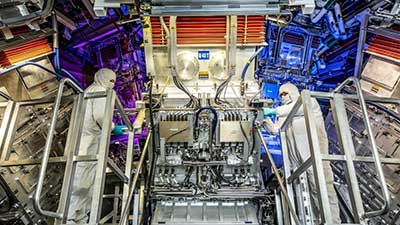Date: 15/12/2022
Relevance: GS-3: Energy, Environmental Pollution, and Degradation
Key Phrases: Nuclear Fusion and Fission, Lawrence Livermore National Laboratory (USA), Carbon Content, Radioactive, Climate Change, COP21 Paris Summit, Greenhouse Gasses, Energy security, Sustainable Energy Source.
Why in the News?
- Recently, the researchers of The Lawrence Livermore National Laboratory (USA) announced a historic nuclear fusion breakthrough that could pave the way for alternative clean energy sources.
Key Highlights:
- It's a technology that has the potential to one day accelerate the planet's shift away from fossil fuels, which are the major contributors to climate change.
- Most of the fusion reactor concepts under development will use a mixture of deuterium and tritium - hydrogen atoms that contain extra neutrons.
What is Nuclear Fusion?
- Nuclear fusion is the process by which two light atomic nuclei
combine to form a single heavier one while releasing massive amounts of
energy.
- Because the total mass of that single nucleus is less than the mass of the two original nuclei, the leftover mass is energy that is released in the process.
- Example- The sun, along with all other stars, is powered by nuclear fusion reaction.
- Fusion reactions take place in a state of matter called plasma — a hot, charged gas made of positive ions and free-moving electrons with unique properties distinct from solids, liquids or gasses.
- Scientists have long understood how nuclear fusion has worked and have
been trying to duplicate the process on Earth as far back as the 1930s.
- Current efforts focus on fusing a pair of hydrogen isotopes deuterium and tritium and for the first time, scientists are able to engineer a reaction that produced more power than was used to ignite it.
Clean Energy
- About
- Clean energy is energy that comes from renewable, zero-emission sources that do not pollute the atmosphere when used. For example, Solar Energy, Wind Energy, Nuclear Energy, etc.
- India has overachieved its commitment made at COP 21- Paris Summit by already meeting 40% of its power capacity from non-fossil fuels- almost nine years ahead of its commitment.
- Why is it Important?
- These are environmentally friendly since there is no negative impact on the environment by the use of clean energy.
- Clean energy reduces the risk of environmental disasters, such as fuel spills, etc.
- It helps to create reliable power supplies to enhance energy security.
Sun’s Nuclear Fusion
- To fuse in our sun, nuclei need to collide with each other at extremely high temperatures, around ten million degrees Celsius.
- The high temperature provides them with enough energy to overcome their mutual electrical repulsion.
- Once the nuclei come within a very close range of each other, the attractive nuclear force between them will outweigh the electrical repulsion and allow them to fuse.
- For this to happen, the nuclei must be confined within a small space to increase the chances of collision.
- In the sun, the extreme pressure produced by its immense gravity creates the conditions for fusion.

How Valuable would this be?
- If nuclear fusion can be replicated on earth at an industrial scale, it
could provide virtually limitless clean, safe, and affordable energy
to meet the world’s demand.
- Fusion could generate four times more energy per kilogram of fuel than fission (used in nuclear power plants) and nearly four million times more energy than burning oil or coal.
- The elements needed for nuclear fusion are available in seawater.
- Nuclear fusion does not emit radioactive material, carbon dioxide and other greenhouse gasses into the atmosphere, so it could be a long-term source of low-carbon electricity from the second half of this century onwards.
- Furthermore, as the fusion process is difficult to start and maintain,
there is no risk of a runaway reaction and meltdown.
- Fusion can only occur under strict operational conditions, outside of which (in the case of an accident or system failure), the plasma will naturally terminate, lose its energy very quickly and extinguish before any sustained damage is done to the reactor.
Why is Fusion so Hard?
- Extreme Heat and Pressure
- It takes more than extreme heat and pressure.
- Precision
- It also takes precision. The energy from the lasers must be applied precisely to counteract the outward force of the fusion fuel.
- Complexity
- It’s harder to produce electricity in a power plant.
- For example, the lab’s lasers can only fire a few times a day.
- To produce energy, they would need to fire rapidly and capsules would need to be inserted multiple times a minute, or even faster.
- Efficiency
- Another challenge is to increase efficiency. The lasers require a lot of electrical energy, and researchers need to figure out a way to reproduce their results in a much more cost-effective way.
Conclusion:
- There are years more to wait before fusion could one day - maybe - be used to produce electricity in the real world. But the promise of fusion is enticing. If harnessed, it could produce nearly limitless, carbon-free energy to supply humanity’s electricity needs without raising global temperatures and worsening climate change.
Source: The Hindu
Mains Question:
Q. What is the potential of using Nuclear fission as the clean energy source? Also, state the associated challenges. (150 Words)








